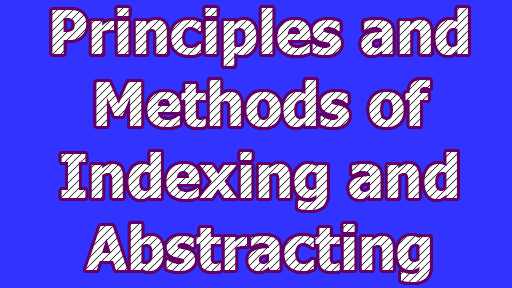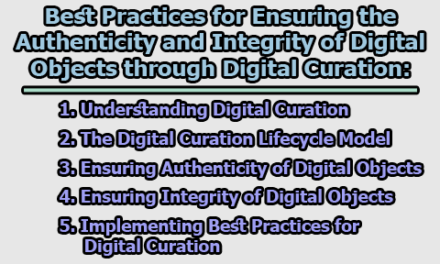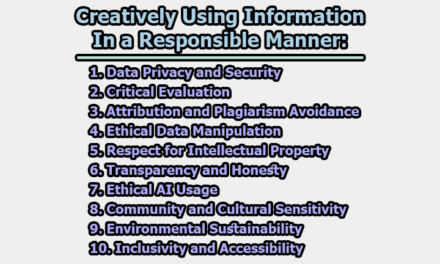Principles and Methods of Indexing and Abstracting:
In the ever-expanding realm of information and knowledge, indexing and abstracting serve as indispensable tools that facilitate efficient access to vast amounts of data and documents. These vital processes are at the core of information organization and retrieval, enabling users to navigate through a sea of information with ease. Indexing involves creating systematic lists of terms, keywords, or subject headings to represent the content of documents, while abstracting provides concise summaries of their main points. By adhering to specific principles and employing various methods, indexing and abstracting aim to enhance information retrieval, save time and effort for users, and support critical evaluation of resources. In this article, we will delve into the principles and methods that govern indexing and abstracting, shedding light on their significance and impact on modern information management.
Objectives of Indexing and Abstracting:
The primary objectives of indexing and abstracting can be further elaborated as follows:
a) Enhancing Information Retrieval: Indexing and abstracting streamline the process of finding relevant information by providing organized access points and concise summaries of documents. Users can quickly identify relevant resources without having to read each document in its entirety.
b) Improving Search Precision: By employing controlled vocabularies and standardized subject headings, indexing ensures that documents are categorized accurately, leading to more precise search results and reducing information overload.
c) Saving Time and Effort: Indexes and abstracts condense the content of documents, making it easier for users to evaluate their relevance quickly. This saves time and effort, especially when dealing with a large number of documents.
d) Supporting Information Evaluation: Abstracts allow users to assess the quality, content, and relevance of documents, enabling them to prioritize sources based on their research needs.
e) Facilitating Subject Browsing: Indexes enable users to explore related topics and subjects, encouraging serendipitous discovery and broadening their knowledge base.
f) Enabling Cross-Referencing: Through cross-referencing, users can explore interconnected information across various topics, facilitating multidisciplinary research and a holistic understanding of complex subjects.
Principles of Indexing:
The principles of indexing are essential guidelines that ensure consistency and accuracy in organizing and representing information. Elaborating on the principles discussed earlier:
- Exhaustiveness: Indexing should encompass all significant terms and concepts found in a document, leaving no crucial element omitted. This ensures comprehensive coverage of the document’s content.
- Specificity: Index terms should be precise and unambiguous, reflecting the content accurately. Specific terms lead to more relevant search results and avoid confusion caused by ambiguous or vague language.
- Consistency: Consistent usage of index terms is crucial to avoid confusion and maintain coherence across the index. Synonyms or related terms should be cross-referenced to guide users to the correct entry.
- Non-Redundancy: Index entries should avoid duplicating information unnecessarily. Each concept or term should be indexed once, and cross-referencing can be used to link related entries.
- Hierarchy: Subject indexing often involves hierarchical organization, where broader categories are subdivided into narrower subcategories, allowing users to navigate through different levels of specificity.
- Objectivity: Indexing should be objective and impartial, free from personal biases or interpretations, ensuring fair representation of the document’s content.
- User-Oriented: The index should be designed with the users’ needs in mind, using terms and language that align with their information-seeking behavior and understanding.
Methods of Indexing:
To cater to various types of materials and information, different methods of indexing are employed:
- Keyword Indexing: This method involves selecting relevant keywords or terms directly from the document’s content. Keyword indexes are widely used in digital environments and web-based search engines.
- Subject Indexing: Subject indexing assigns specific subject headings from controlled vocabularies like Library of Congress Subject Headings (LCSH) or Medical Subject Headings (MeSH). It ensures consistent representation of the content’s main themes or topics.
- Citation Indexing: Citation indexing focuses on the references and citations included in a document, establishing connections between related works and authors. This method is common in academic databases.
- Alphabetical Indexing: Organized in alphabetical order, this index lists terms or concepts with page numbers or location identifiers where they appear in the document.
- Hierarchical Indexing: Hierarchical indexing organizes index terms into a tree-like structure, with broader categories at the top and narrower subcategories below, aiding in hierarchical browsing.
- Metadata Indexing: Digital resources often include metadata elements like author, title, and publication date. Indexing based on these elements enhances resource discovery.
Principles of Abstracting:
Abstracting involves summarizing the main points of a document concisely and effectively. The principles guiding abstracting include:
- Comprehensiveness: Abstracts should provide a comprehensive overview of the document’s content, capturing the essential points and main themes.
- Clarity: Abstracts should be written in clear and straightforward language, making them accessible to a broad audience.
- Conciseness: Abstracts should be succinct, conveying the key information within a limited word count.
- Objectivity: Abstracts should be objective and unbiased, presenting the document’s content without subjective interpretation.
- Informativeness: Abstracts should offer enough information to enable users to determine the document’s relevance to their needs without having to read the full text.
Methods of Abstracting:
Abstracting methods vary based on the level of detail and context:
- Indicative Abstracts: These abstracts provide a general indication of the document’s content, including its main topics and scope without delving into specific details.
- Informative Abstracts: Informative abstracts offer a more detailed summary, highlighting the key points, results, and conclusions of the document.
- Structured Abstracts: Commonly used in scientific articles, structured abstracts follow a predefined format, often including sections such as purpose, methods, results, and conclusion.
- Descriptive Abstracts: Descriptive abstracts provide a comprehensive summary of the document’s content, useful for library catalogs and databases.
- Critical Abstracts: Critical abstracts include evaluative comments or critiques of the document’s quality, relevance, or methodology, going beyond a mere summary.
It is apparent that indexing and abstracting play pivotal roles in managing and harnessing the vast reservoirs of information available today. The principles of exhaustiveness, specificity, consistency, non-redundancy, hierarchy, objectivity, and user-orientation guide the indexing process, ensuring accurate representation and efficient retrieval of information. Simultaneously, abstracting principles of comprehensiveness, clarity, conciseness, objectivity, and informativeness result in concise yet informative document summaries. Employing various methods, such as keyword indexing, subject indexing, citation indexing, and hierarchical indexing, among others, caters to diverse information needs and enhances the effectiveness of information retrieval systems. The combination of these principles and methods empowers users to explore, evaluate, and utilize information effectively, making indexing and abstracting indispensable tools for knowledge discovery and research across various domains. Embracing these practices is crucial for information professionals and researchers as they navigate the ever-expanding landscape of information and strive to make meaningful contributions to their respective fields.
FAQs:
What is indexing, and what are its main objectives?
Indexing is the process of creating a systematic arrangement of terms, keywords, or subject headings to represent the content of documents or a collection of documents. Its main objectives are to enhance information retrieval, improve search precision, save time and effort for users, support information evaluation, facilitate subject browsing, and enable cross-referencing.
What are the fundamental principles of indexing?
The fundamental principles of indexing include exhaustiveness (covering all significant terms and concepts), specificity (using precise and unambiguous terms), consistency (maintaining uniformity in indexing), non-redundancy (avoiding duplication of information), hierarchy (organizing index terms in a hierarchical structure), objectivity (remaining impartial and unbiased), and user-orientation (designing the index to meet users’ needs).
How does subject indexing differ from keyword indexing?
Subject indexing involves assigning specific subject headings from controlled vocabularies to documents, reflecting their main themes or topics. It follows standardized rules and enhances precision in information retrieval. On the other hand, keyword indexing involves selecting relevant keywords directly from the document’s content, which may lead to broader and potentially less precise search results.
What are the main objectives of abstracting, and how does it complement indexing?
The main objectives of abstracting are to provide a concise overview of a document’s main points, save time for users in evaluating document relevance, and support information retrieval and knowledge discovery. Abstracting complements indexing by offering a condensed summary of a document’s content, allowing users to quickly assess its relevance without having to read the entire document.
What are the principles guiding the abstracting process?
The principles guiding the abstracting process include comprehensiveness (capturing essential points of the document), clarity (using clear and straightforward language), conciseness (providing a brief summary), objectivity (remaining neutral and unbiased), and informativeness (offering enough information for users to assess document relevance).
What are some common methods of indexing and abstracting?
Common methods of indexing include keyword indexing, subject indexing, citation indexing, alphabetical indexing, hierarchical indexing, and metadata indexing. For abstracting, various methods include indicative abstracts, informative abstracts, structured abstracts, descriptive abstracts, and critical abstracts.
How do indexing and abstracting contribute to the efficiency of information retrieval?
Indexing and abstracting enhance information retrieval efficiency by providing organized access points to documents (indexing) and concise summaries of their content (abstracting). Users can quickly identify relevant resources and assess their relevance without having to read the full text, saving time and effort.
How do the principles and methods of indexing and abstracting benefit information professionals and researchers?
Embracing the principles and methods of indexing and abstracting empowers information professionals and researchers to organize information effectively, optimize information retrieval systems, and enhance the discoverability of relevant resources. By following these practices, they can make valuable contributions to their respective fields and promote efficient knowledge dissemination and exploration.
References:
- Lancaster, F. W. (2003). Indexing and Abstracting in Theory and Practice. 3rd ed. Information Today, Inc.
- Taylor, A. G., & Joudrey, D. N. (2017). The Organization of Information. 4th ed. Libraries Unlimited.
- Cleveland, D. B., & Cleveland, A. D. (2018). Introduction to Indexing and Abstracting. 5th ed. Libraries Unlimited.
- Soergel, D. (2004). Indexing Languages and Thesauri: Construction and Maintenance. Information Today, Inc.
- Bean, C. A., & Green, R. (2001). Indexing Books. Information Today, Inc.
- Miksa, F. L. (1998). The DDC, the Universe of Knowledge, and the Post-Modern Library. Libraries Unlimited.
- Satija, M. P. (2011). Indexing: A Nuts-and-Bolts Guide for Technical Writers. CRC Press.
- Lancaster, F. W. (1991). Indexing and Abstracting: An International Bibliography. Gower Publishing Company.
- Williamson, N. J. (2008). Abstracting and Indexing. Libraries Unlimited.
- Reitz, J. M. (2014). Online Dictionary for Library and Information Science. ABC-CLIO.

Library Lecturer at Nurul Amin Degree College










